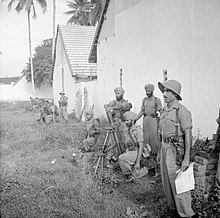| 26th Indian Infantry Division | |
|---|---|
 Formation sign of the 26th Indian Infantry Division. Formation sign of the 26th Indian Infantry Division. | |
| Active | 1942–1945 |
| Country | |
| Allegiance | |
| Branch | |
| Type | Infantry |
| Size | Division |
| Nickname(s) | Tiger Head Division |
| Engagements | Burma Campaign |
| Commanders | |
| Notable commanders | Field Marshall S. H. F. J. Manekshaw Maj Gen C. E. N. Lomax Maj Gen H. M. Chambers |
The 26th Indian Infantry Division, was an infantry division of the Indian Army during World War II. It fought in the Burma Campaign.
History
When the Japanese invaded Burma in 1942, the various units in training or stationed around Barrackpur near Calcutta in India were hastily formed into the "Calcutta" Division on 20 March 1942. On 15 May, the division was retitled the Indian 26th Division. The division's badge was a Bengal tiger stepping through a blue triangle, representing the "delta" of the Ganges River, on a black background.
For much of 1942, the division was heavily engaged in internal security, and not regarded as battle-worthy due to lack of training and transport. It formed part of Indian XV Corps, but late in 1942, it was taken over directly by Eastern Army.
For the First Arakan offensive, all the division's brigades were detached one by one and committed to the offensive under the 14th Indian Infantry Division. In March, the offensive stalled and the HQ of 26th Division relieved that of the 14th Division, taking over the Arakan front too late to prevent a minor disaster. After this the British fell back almost to their starting point on the Indian frontier.
Once reorganised, the division was in reserve for the first part of the Second Arakan Offensive, once again under XV Corps. When a Japanese counter-attack at Ngakyedauk cut off the forward troops, 26th Division was deployed to relieve them. It fought down the coastal plain to reopen the roads by which the 5th Indian Division was supplied.
After the battle ended with the repulse of the Japanese attackers, the division took over the 5th Division's front and took part in the capture of two vital railway tunnels. After this, the Arakan offensive wound down to spare troops and resources for the battles in Manipur. The division was withdrawn during the monsoon rains to recuperate.

Beginning in late 1944, the division was committed once again to the Arakan. During the Third Arakan Offensive and subsequent operations, 26th Division took part mainly in amphibious operations, including the unopposed capture of Akyab Island, and the Battle of Ramree Island. Finally in April and May 1945, the division took part in Operation Dracula, the capture of Rangoon.


After the Japanese surrender, the division, under the command of Henry Chambers, reinforced other troops in Java and Sumatra, where the end of the war brought widespread disorder. The division was formally disbanded in India on 31 August 1945, but most of its units were stationed in Sumatra at Padang and Medan until November 1946, when they embarked at the port of Belawan to be disbanded in India.
Order of battle
as of 1 April 1944
- 4th Indian Infantry Brigade
- 1st Battalion, Wiltshire Regiment
- 2nd Battalion, 7th Rajput Regiment
- 2nd Battalion, 13th Frontier Force Rifles
- 36th Indian Infantry Brigade
- 5th Battalion, 16th Punjab Regiment
- 8th Battalion, 13th Frontier Force Rifles
- 1st Battalion, 8th Gurkha Rifles
- 71st Indian Infantry Brigade
- 1st Battalion, Lincolnshire Regiment
- 5th Battalion, 1st Punjab Regiment
- 1st Battalion, 18th Royal Garhwal Rifles
- Divisional Troops
- 12th Battalion, 12th Frontier Force Regiment (divisional machine gun battalion)
- 160th (Jungle) Field Regiment Royal Artillery
- 20th Mountain Regiment Royal Indian Artillery
- 72nd, 28th, 98th Field Companies, Royal Indian Engineers
- 128th Field Park Company Indian Engineers
- 44th, 48th, 51st, 58th, Animal Transport Companies, IASC
- 44th, 75th, 166th, General Purpose Transport Companies, IASC
- 1st, 46th, 48th, Indian Field Ambulances, IAMC
- 26th Indian Division Provost Unit
- 26th Indian Division Signals Unit
- 54th, 55th Indian Workshop Companies, IEME
- 26th Indian Division Recovery Unit, IEME
Assigned brigades
All these brigades were assigned or attached to the division at some time during World War II
- 71st Indian Infantry Brigade
- 109th Indian Infantry Brigade
- 4th Indian Infantry Brigade
- 36th Indian Infantry Brigade
- British 6th Infantry Brigade
- British 23rd Infantry Brigade
- 55th Indian Infantry Brigade
- British 14th Infantry Brigade
- 114th Indian Infantry Brigade
- British 29th Infantry Brigade
- 2nd (West Africa) Infantry Brigade
- 22nd (East Africa) Infantry Brigade
References
- "26 Division units". Order of Battle. Archived from the original on 30 September 2007. Retrieved 22 October 2009.
Bibliography
- Cole, Howard (1973). Formation Badges of World War 2. Britain, Commonwealth and Empire. London: Arms and Armour Press.
External links
- "26 Indian Infantry Division". Orders of Battle.com.
- Burma Star organisation site
- British Military History - Indian Divisional Histories
| Divisions of the Indian Army during World War II | |
|---|---|
| Airborne | |
| Armoured | |
| Infantry | |
| Long-range Penetration | |
| Training | |
| Deception / LoC | |
| Emergency | |
- Indian World War II divisions
- British Indian Army divisions
- Military units and formations established in 1942
- Military units and formations of the British Empire in World War II
- Military units and formations in Burma in World War II
- 1942 establishments in India
- 1945 disestablishments in India
- Military units and formations disestablished in 1945